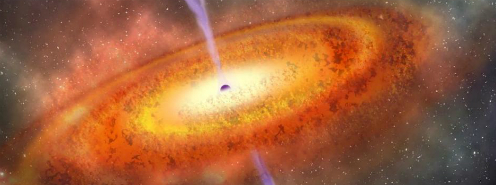NBIA researchers publish the answer to a century-old cosmic mystery in Science

Assistant Professor Markus Ahlers, Niels Bohr Professor Subir Sarkar and postdoc Dr Mohamed Rameez are co-authors of two papers in Science which report evidence that the blazar TXS 0506+056 is a likely source of high-energy neutrinos detected by the IceCube experiment. This was announced at a NSF Press conference in Washington on 12 July and the story is making headlines around the world. Why all the fuss?
Ever since 1912 when Victor Hess showed that the Earth is being continuously bombarded by high energy particles from all directions these "cosmic rays" have posed an enduring mystery: How are they accelerated to such huge energies (up to 10^11 GeV)? Where do they come from?
Hess was awarded the Nobel Prize (1936) along with Carl Anderson who discovered in the cosmic radiation the first antiparticle - the positron predicted by Dirac’s relativistic quantum field theory. This was the beginning of the field of high energy physics and there were further major discoveries, e.g. of the pion predicted by Hideki Yukawa by Cecil Powell (Nobel prize 1950). Those who invented the tools for these discoveries also won Nobel Prizes - Charles Wilson in 1927 for the cloud chamber and Patrick Blackett in 1948 for its further development.
However the questions posed have remained unanswered for over a century. Among the suspects for the cosmic accelerators are quasars - supermassive black holes at the centres of galaxies that are accreting surrounding matter and shooting out relativistic plasma jets. If a jet happens to be pointed toward Earth it outshines the host galaxy and this type of quasar is called a blazar.
Since cosmic rays are charged their paths are deflected by intervening magnetic fields and cannot be traced back to their origin. But their interactions with ambient matter & radiation will create high energy γ-rays & neutrinos which do point back to their sources. Gamma-rays can be absorbed by intervening matter but neutrinos by virtue of their weak interactions can travel freely through the universe.
Conversely detecting them also requires a massive particle detector and the IceCube observatory buried below the South Pole is the world's largest. Subir Sarkar has been a member of the IceCube collaboration since its inception in 2004 and enabled the NBI Discovery Center to join in 2013 - just a few months before IceCube made the breakthrough discovery of high energy cosmic neutrinos. However there are only a handful of events per year so it has not been possible to securely identify the sources.
The new development is that of ‘multi-messenger astronomy’ - an emerging field in which Markus Ahlers is expert. On 22 Sept 2017, IceCube detected a ~290 TeV energy muon neutrino from a direction in the constellation Orion. Just 44 seconds later, thanks to a trigger set up by Mohamed Rameez who also did the initial event reconstruction, an alert went out to the entire astronomical community. On 28 Sept, the Fermi Large Area Telescope Collaboration reported that the direction of the neutrino was within 0.1° of the blazar TXS 0506+056 at a redshift of 0.34 which was in a flaring state at the time with enhanced γ-ray activity in the GeV range. Follow-up observations by the Major Atmospheric Gamma Imaging Cherenkov (MAGIC) telescope on La Palma revealed periods where the γ-ray flux from the blazar reached energies up to 400 GeV. The overall significance of the associations is just over 3 sigma. Moreover a search of IceCube archival data found 13±5 events over background from the same direction during the previous 9.5 years of operation. This has a significance of 3.5 sigma (p-value of 2x10^-4). The conclusion is that the observations pinpoint a likely source of high-energy cosmic rays.
Although the result is of most interest to cosmic ray astrophysics, there is the possibility to use this for probing fundamental physics too. The study of neutrino oscillations at hundreds of TeV over a baseline of billions of light years can potentially probe possible quantum gravity effects on space-time structure at the Planck scale. This can induce decoherence resulting in a non-standard flavour ratio being observed at Earth. The sky is indeed the limit.
